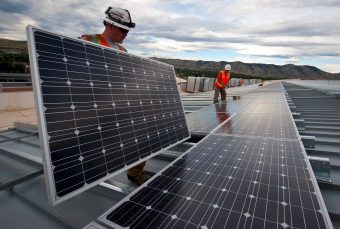
Starting in 2012, Stanford University began an ambitious program to bring solar power to its Silicon Valley campus. The University’s Department of Sustainability and Energy Management reviewed 20 proposals from solar energy companies and analyzed 60 potential sites for solar installations before selecting 15 buildings most suited to rooftop solar.
After those 15 systems were completed, Stanford selected another 15 buildings to get the solar panel treatment. “Fortunately, the main grid of campus is roughly on an east-west axis, meaning that the backs of our buildings are close to directly facing south — optimum direction for maximizing photovoltaic energy production,” said Scott Gould, senior energy engineer at Stanford. “We have several flat roofs — such as Bing Concert Hall and Braun Music Center — that are also ideal for photovoltaics. We worked closely with University Architect David Lenox on the project. He and his team provided input every step of the way.”
The installation of solar panels at those 15 new buildings was completed at the end of February, allowing Stanford to add 4.5 megawatts of renewable solar energy to its local electrical grid. “The addition of on-site solar generation not only reduces the overall cost of electricity supply to our buildings, but will also help offset new campus electrical loads from plug-in buses and cars to help preserve the capacity of our campus high-voltage distribution system to support additional teaching and research activities,” said Joseph Stagner, executive director of the Department of Sustainability and Energy Management at Stanford.
The campus solar systems, plus the Stanford Solar Generating Station, which began operating in December 2016, will produce 53% of the university’s electricity. For the rooftop solar panel project, the university teamed up with SunPower, the solar energy company that designed and built the Stanford Solar Generating Station. Stanford’s sustainability efforts extend to more than solar power generation. The university’s cutting edge energy supply system known as the Stanford Energy System Innovations project also includes a revolutionary heat recovery system for the more efficient heating and cooling of campus buildings.
Additional enhancements now under study include a new high-voltage transmission line connecting SLAC National Accelerator Laboratory, Stanford, and the City of Palo Alto to further reduce electricity cost and increase system reliability and the use of ground and water heat exchange to further increase system efficiency and save water. Together, the new solar energy resources and renewables supplied by the balance of Stanford’s grid electricity purchases total 65% of university electricity use and reduce Stanford’s greenhouse gas emissions by 68 percent.
Source: cleantechnica.com


